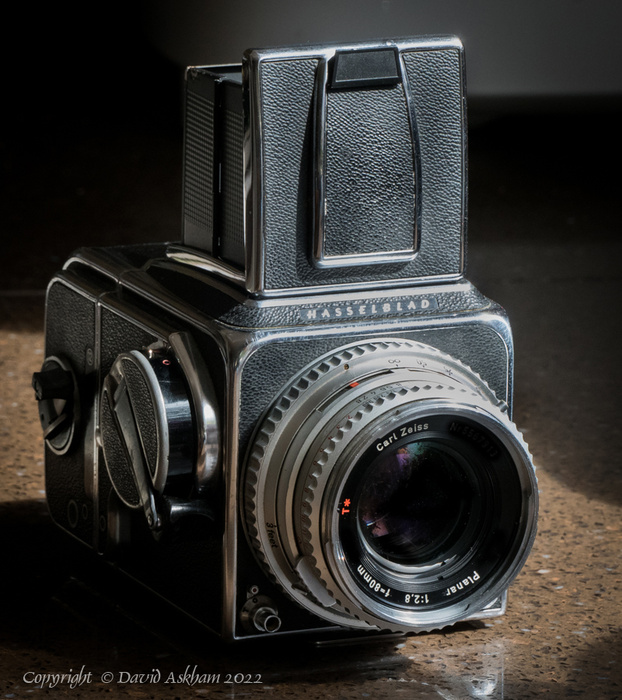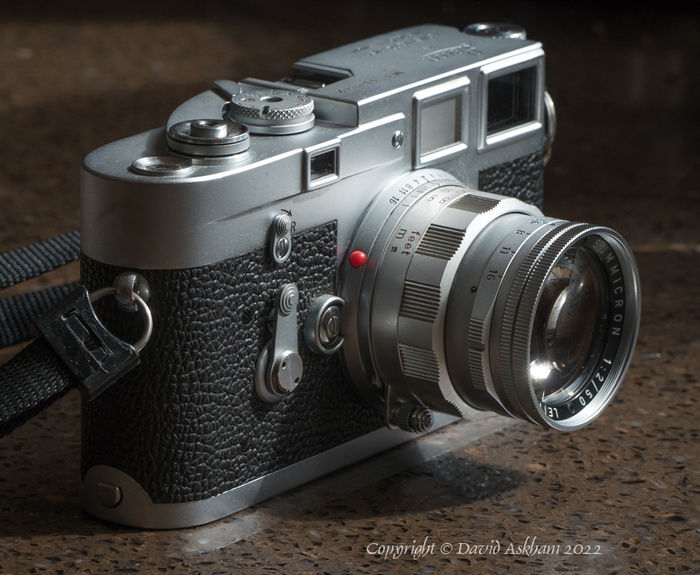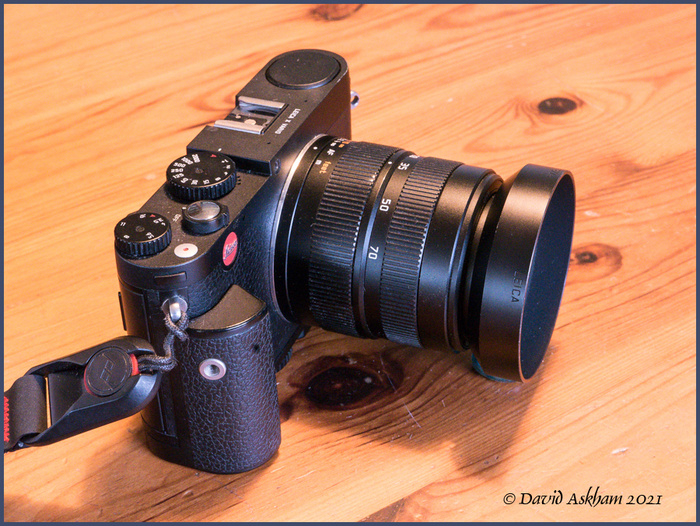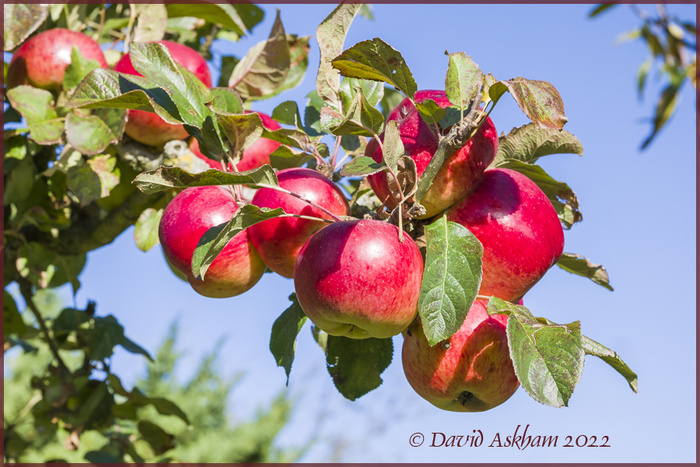My Favourite lens (2022)
25th August 2022
Written & Illustrated
By
David Askham
‘My favourite lens’ is a recurring theme of discussions on photographic forums, certainly among active photographers. Sometimes they make for interesting reading, especially if the author has an unusual argument to advance. At first, I participated; but now I generally avoid such discussions, mainly because of their repetitive nature. However, it does no harm to consider the question and review my personal thoughts on the lenses I currently use. Bear in mind, though, that I am a retired. Those, working as professional photographers, will almost certainly have different priorities.
There is a good reason why many wise owners say, ‘Never sell a lens’. Camera bodies, yes, but a lens is a different matter. I have been amazed to read that some owners have bought and sold examples of the same lens, multiple times, such has been their haste in selling, before remorse sets in, and they search for a matching replacement. Good business for the retailers. I am in the opposite camp and rarely sell a lens. However, I do regret selling an early 9 cm Tele-Elmarit, after thirty years of ownership, when I look at some of my portrait pictures taken with that lens. I part-exchanged it when buying a much younger, coded, 9 cm Elmarit which, undoubtedly, produces higher quality images. But the older lens was much kinder when used to capture female portraits, and I miss that subtle quality.
Why sell a lens?
A typical reason for selling a lens is to replace the focal length with a faster or more modern version. One reason given for the choice of a Summilux lens (f/1.4), or the Noctilux (f1), is the desire for a very limited zone of sharpness. Razor-thin, as some describe it. A sharp subject floats in a ‘sea of softness’. The effect is greater at longer focal lengths; less so with wide angle lenses. Because of the design and manufacturing complexities, Summilux and Noctilux lenses are among the most expensive versions to buy. I guess they sell in smaller numbers, generally. While I quite like the occasional pictorial effect of limited depth of field, in practice most lenses are stopped down for the opposite reason. It seems pointless to me to pay a premium for a seldom-used feature when a Summicron (f/2) or Elmarit (f/2.8) in the same focal length, more often than not, meets my requirements.
There are good arguments for buying a Summilux or Noctilux lens. For photographers who regularly work in low-light locations, such as indoor music or sports events, one of the fastest lenses can work very well and is fully justified. But for general photography, a slower lens makes for a lighter and more compact piece of kit when working for long periods.
Do I have a favourite lens? Possibly not, because I have to think long and hard even to name one. There is one very good reason. When I bought my first camera, long before digital photography, cameras with interchangeable lenses were few and far between. I am speaking of the 1940s and 1950s, even the 1960s, when roll film cameras were the norm. The cameras came with a lens built into the body, and that is what you used. 6×6 cm was then regarded as a ‘miniature’ format, compared with studio cameras using glass plates or cut film. A lot of professionals used Rolleiflex, or similar twin-lens reflex cameras. So the standard lens, of around 75 mm focal length, was the only choice. Hasselblad was one exception, producing a carefully designed range of lenses for professional use.

35 mm Leica, Zeiss Contax and Ihagee Exakta cameras were the costly exceptions, having a limited range of interchangeable lenses. These lasted until the Asian factories started to design and manufacture more affordable models. During the second half of the 20th century, photographers started to be spoiled for choice as interchangeable lenses became available in vast numbers, at various price-points.

When I bought my Leica M3, it was normal to include a 50 mm lens with the body. I added a 28 mm and 90 mm lenses. Those three lenses served me for 35 years. Occasionally I considered getting a 135 mm Elmar, but that was only added many years later. On reflection, most of my photography was done with a 50 mm Summicron, from the Mandler era. So that really should be my favourite lens. It probably is. It is an excellent performer, reliable and renders subjects to my full satisfaction.
Fast-forward to the 21st century, and the introduction of the crop-sensor Leica M8, focal lengths became slightly distorted. My versatile Leica Tri-Elmar 28-35-50 mm, bought to join my M6, behaved like a different lens. TE 35 performed more nearly to match my former 50 mm preference. Then the full-frame Leica M9 reverted to conventional rendering of focal-lengths.

A decade later, and APS-C entered the fray, in my case with the purchase of the compact Leica X1. It was fitted with a 24 mm Elmarit which equated to a conventional 35 mm lens, by then a universally acclaimed first preference focal-length for full-frame cameras. The Leica X-Vario followed, which had an exceptional zoom lens covering focal-lengths from 28 mm to 70 mm. A similar lens was available on the later Leica CL, which was a system camera. The standard zoom lens conveniently embodied the most used mid-range focal lengths, itself becoming a favourite. Confused? Read on.
Alternative lenses
My first interchangeable lens camera was a 1930s VP Exakta Model C, with an optional slide back. It came with a 75 mm standard Tessar lens. It was a well-used copy with sloppy focusing, which I had serviced. Results were superb. Alternative lenses were very hard to find. Eventually I discovered a Dallmeyer Dallon long-focus lens (cannot recall its focal length, but about twice the normal), which opened up interesting new possibilities. I enjoyed using the tele-lens, but the camera was not suited to vertical portraits; so it was not a candidate for the ‘favourite’ accolade.
For my Leica cameras, I still have a fairly limited range of lenses; but my range increases the system’s versatility. But not one of them emerges as a clear favourite. Zoom lenses are so good, nowadays, that any one of them could be a candidate, depending on the job in hand. So that muddies the waters again.

I started this article trying to answer the question of What is your favourite focal length or actual lens, which you could live with for some years? My 50 mm Summicron from 1960s could well be mine. However, that leaves the question, what about zoom lenses?
The Value of Analysis
After analysing lenses in daily use, I found that zoom lenses tend to be the ones I use most, nowadays. Accordingly, I will repeat the exercise above and declare my favourite from this wider field. My choice will come from zoom lenses available in Leica L-mount, primarily used with my CL camera.
Leica produced three zoom lenses in L-mount for the CL and TL cameras:
1. A wide-angle zoom (11-23 mm F3.5-5.6 (Equiv. 17-35 mm))
2. A standard zoom (18-56 mmF3.5-5.6 (Equiv. 28-85 mm))
3. A tele-zoom (55-135 mm F3.5-5.6 (Equiv. 80-200 mm))
Of these three lenses, I possess the standard and tele-zooms, which cover almost all of my needs. The standard zoom has been my work-horse lens and the most used. It is excellent and has only been found wanting in the relatively slow starting aperture and at close distances. That is less important in everyday photography. When I require a faster lens, I resort to adding one of my M-mount prime lenses. On the other hand, the tele-zoom has excelled and had a bigger influence on my work than I expected. So, what do I like about it?
For a lens of such flexibility and reach, it is remarkably compact and is a joy to hold and operate. Previously, I had used long-focus lenses for specific purposes, principally ground-to-air photography or animal portraits. But with variable focal-lengths, in the zoom lens, I found I began using it more for garden and general landscapes, composing a picture more tightly and focusing interest. Even portraiture became more interesting, with selective focusing and background isolation. Despite it not being my most used lens, it certainly qualifies as being my favourite zoom lens.


Conclusions
So there we have it. A quest to find my favourite lens ends with two being selected. My 50 mm Summicron lens, of which I have two (one from the 1960s and a more modern one from this century) is my favourite prime lens. Unexpectedly, I have added my L-mount 55-135 mm tele-zoom as my joint favourite lens. Effectively that is equivalent to 80-200 mm in full-frame Actually I think I will declare it my favourite lens today because I love looking for pictures within pictures, both in the landscape and in gardens. It is a fantastic lens for meeting this task.
By
David Askham
‘My favourite lens’ is a recurring theme of discussions on photographic forums, certainly among active photographers. Sometimes they make for interesting reading, especially if the author has an unusual argument to advance. At first, I participated; but now I generally avoid such discussions, mainly because of their repetitive nature. However, it does no harm to consider the question and review my personal thoughts on the lenses I currently use. Bear in mind, though, that I am a retired. Those, working as professional photographers, will almost certainly have different priorities.
There is a good reason why many wise owners say, ‘Never sell a lens’. Camera bodies, yes, but a lens is a different matter. I have been amazed to read that some owners have bought and sold examples of the same lens, multiple times, such has been their haste in selling, before remorse sets in, and they search for a matching replacement. Good business for the retailers. I am in the opposite camp and rarely sell a lens. However, I do regret selling an early 9 cm Tele-Elmarit, after thirty years of ownership, when I look at some of my portrait pictures taken with that lens. I part-exchanged it when buying a much younger, coded, 9 cm Elmarit which, undoubtedly, produces higher quality images. But the older lens was much kinder when used to capture female portraits, and I miss that subtle quality.
Why sell a lens?
A typical reason for selling a lens is to replace the focal length with a faster or more modern version. One reason given for the choice of a Summilux lens (f/1.4), or the Noctilux (f1), is the desire for a very limited zone of sharpness. Razor-thin, as some describe it. A sharp subject floats in a ‘sea of softness’. The effect is greater at longer focal lengths; less so with wide angle lenses. Because of the design and manufacturing complexities, Summilux and Noctilux lenses are among the most expensive versions to buy. I guess they sell in smaller numbers, generally. While I quite like the occasional pictorial effect of limited depth of field, in practice most lenses are stopped down for the opposite reason. It seems pointless to me to pay a premium for a seldom-used feature when a Summicron (f/2) or Elmarit (f/2.8) in the same focal length, more often than not, meets my requirements.
There are good arguments for buying a Summilux or Noctilux lens. For photographers who regularly work in low-light locations, such as indoor music or sports events, one of the fastest lenses can work very well and is fully justified. But for general photography, a slower lens makes for a lighter and more compact piece of kit when working for long periods.
Do I have a favourite lens? Possibly not, because I have to think long and hard even to name one. There is one very good reason. When I bought my first camera, long before digital photography, cameras with interchangeable lenses were few and far between. I am speaking of the 1940s and 1950s, even the 1960s, when roll film cameras were the norm. The cameras came with a lens built into the body, and that is what you used. 6×6 cm was then regarded as a ‘miniature’ format, compared with studio cameras using glass plates or cut film. A lot of professionals used Rolleiflex, or similar twin-lens reflex cameras. So the standard lens, of around 75 mm focal length, was the only choice. Hasselblad was one exception, producing a carefully designed range of lenses for professional use.

Hasselblad with standard 80 mm Carl Zeiss Planar lens, a classic of its time
35 mm Leica, Zeiss Contax and Ihagee Exakta cameras were the costly exceptions, having a limited range of interchangeable lenses. These lasted until the Asian factories started to design and manufacture more affordable models. During the second half of the 20th century, photographers started to be spoiled for choice as interchangeable lenses became available in vast numbers, at various price-points.

Leica M3 and 50 mm Summicron lens
When I bought my Leica M3, it was normal to include a 50 mm lens with the body. I added a 28 mm and 90 mm lenses. Those three lenses served me for 35 years. Occasionally I considered getting a 135 mm Elmar, but that was only added many years later. On reflection, most of my photography was done with a 50 mm Summicron, from the Mandler era. So that really should be my favourite lens. It probably is. It is an excellent performer, reliable and renders subjects to my full satisfaction.
Fast-forward to the 21st century, and the introduction of the crop-sensor Leica M8, focal lengths became slightly distorted. My versatile Leica Tri-Elmar 28-35-50 mm, bought to join my M6, behaved like a different lens. TE 35 performed more nearly to match my former 50 mm preference. Then the full-frame Leica M9 reverted to conventional rendering of focal-lengths.

Leica M8 and Tri-Elmar 28-35-50mm lens
A decade later, and APS-C entered the fray, in my case with the purchase of the compact Leica X1. It was fitted with a 24 mm Elmarit which equated to a conventional 35 mm lens, by then a universally acclaimed first preference focal-length for full-frame cameras. The Leica X-Vario followed, which had an exceptional zoom lens covering focal-lengths from 28 mm to 70 mm. A similar lens was available on the later Leica CL, which was a system camera. The standard zoom lens conveniently embodied the most used mid-range focal lengths, itself becoming a favourite. Confused? Read on.
Alternative lenses
My first interchangeable lens camera was a 1930s VP Exakta Model C, with an optional slide back. It came with a 75 mm standard Tessar lens. It was a well-used copy with sloppy focusing, which I had serviced. Results were superb. Alternative lenses were very hard to find. Eventually I discovered a Dallmeyer Dallon long-focus lens (cannot recall its focal length, but about twice the normal), which opened up interesting new possibilities. I enjoyed using the tele-lens, but the camera was not suited to vertical portraits; so it was not a candidate for the ‘favourite’ accolade.
For my Leica cameras, I still have a fairly limited range of lenses; but my range increases the system’s versatility. But not one of them emerges as a clear favourite. Zoom lenses are so good, nowadays, that any one of them could be a candidate, depending on the job in hand. So that muddies the waters again.

Leica X-Vario camera and modest, yet superb, zoom lens
I started this article trying to answer the question of What is your favourite focal length or actual lens, which you could live with for some years? My 50 mm Summicron from 1960s could well be mine. However, that leaves the question, what about zoom lenses?
The Value of Analysis
After analysing lenses in daily use, I found that zoom lenses tend to be the ones I use most, nowadays. Accordingly, I will repeat the exercise above and declare my favourite from this wider field. My choice will come from zoom lenses available in Leica L-mount, primarily used with my CL camera.
Leica produced three zoom lenses in L-mount for the CL and TL cameras:
1. A wide-angle zoom (11-23 mm F3.5-5.6 (Equiv. 17-35 mm))
2. A standard zoom (18-56 mmF3.5-5.6 (Equiv. 28-85 mm))
3. A tele-zoom (55-135 mm F3.5-5.6 (Equiv. 80-200 mm))
Of these three lenses, I possess the standard and tele-zooms, which cover almost all of my needs. The standard zoom has been my work-horse lens and the most used. It is excellent and has only been found wanting in the relatively slow starting aperture and at close distances. That is less important in everyday photography. When I require a faster lens, I resort to adding one of my M-mount prime lenses. On the other hand, the tele-zoom has excelled and had a bigger influence on my work than I expected. So, what do I like about it?
For a lens of such flexibility and reach, it is remarkably compact and is a joy to hold and operate. Previously, I had used long-focus lenses for specific purposes, principally ground-to-air photography or animal portraits. But with variable focal-lengths, in the zoom lens, I found I began using it more for garden and general landscapes, composing a picture more tightly and focusing interest. Even portraiture became more interesting, with selective focusing and background isolation. Despite it not being my most used lens, it certainly qualifies as being my favourite zoom lens.

Leica CL and APO-VARIO-ELMAR-TL 1:3.5-4.5/55-135 ASPH. Lens

Rosy apples, high up on an apple tree, was captured effectively using the CL with APO-VARIO-ELMAR-TL 1:3.5-4.5/55-135 ASPH. Lens
Conclusions
So there we have it. A quest to find my favourite lens ends with two being selected. My 50 mm Summicron lens, of which I have two (one from the 1960s and a more modern one from this century) is my favourite prime lens. Unexpectedly, I have added my L-mount 55-135 mm tele-zoom as my joint favourite lens. Effectively that is equivalent to 80-200 mm in full-frame Actually I think I will declare it my favourite lens today because I love looking for pictures within pictures, both in the landscape and in gardens. It is a fantastic lens for meeting this task.
How about you?
What is your favourite lens and why?
Please record a comment and share your choice with others.
What is your favourite lens and why?
Please record a comment and share your choice with others.
==E N D ==
(Text and Pictures – Copyright David Askham, 2022)
Comments
 By Don Morley: Enjoyable and thought provoking article David, thank you. Don
By Don Morley: Enjoyable and thought provoking article David, thank you. Don By David Askham: I am pleased you found my article stimulating, Don. However, I get enormous pleasure by rotating my modest collection of lenses, each one contributing to my love of photography.
By David Askham: I am pleased you found my article stimulating, Don. However, I get enormous pleasure by rotating my modest collection of lenses, each one contributing to my love of photography.